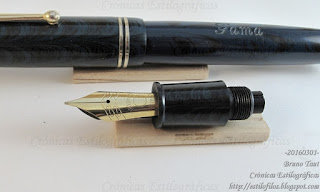That is only part of a major operation. The current building of the Pilot Corporation headquarters will be demolished to erect a new one. These works will take over three years.
Pilot currently has no plan to reopen the pen museum. The pens and other materials on display at it will be taken to a warehouse at the Hiratsuka site where Pilot has its production plant. Thus, Tokyo is about to lose the only pen museum in town. This primary source of information for anyone interested on pens in Japan and on Pilot in particular will be lost. Of course, the information will still exist, but hidden somewhere in Kanagawa province, less accessible, harder to find…
Not many museums like this one exist anywhere in the world, and Japan seems very apt to host one—a active and thriving pen industry, a taste for craftsmanship, a very Japanese way to decorate pens… All that could be seen and enjoyed at the Pen Station.
Over a year ago, January 2015, Pilot opened a small museum on maki-e pens (plus some additional good produced by Pilot maki-e craftsmen) on the grounds of the Hiratsuka plant. It is an interesting initiative, but very small and limited in scope. And far away from Tokyo. However, it is bound to being the only pen museum in Tokyo area.

The old gunpowder manufacturing building is the center of maki-e creation at the Hiratsuka plant. It is also the site of the Pilot Maki-e Museum.
Sure enough, Pen Station, museum & café, will be sadly missed.
The Pen Station is located on Kyobashi 2-6-21, Chuo, Tokyo 104-8304. Phone: 03-3538 3700. Opens Monday to Friday, from 9:30 to 17:00; and Saturdays from 11:00 to 17:00. Sundays closed.
Note added on March 29th 2016:
George Kovalenko is the author of the blog Fountain Pen History, which is an invaluable resource for anyone interested on the history of North American pens. He pointed out that you can virtually visit Pen Station through Google Maps. This is the link: https://www.google.ca/maps/@35.6768921,139.7703936,3a,75y,125.83h,89.73t/data=!3m7!1e1!3m5!1sOAKJ4EblmqkAAAQzVOQZ5A!2e0!3e2!7i13312!8i6656?hl=en . Thanks, George!
Pilot Murex – Pilot Blue-black
Bruno Taut
Nakano, March 14th, 2016
etiquetas: Japón, Tokyo, Pilot
Bruno Taut
Nakano, March 14th, 2016
etiquetas: Japón, Tokyo, Pilot






















































